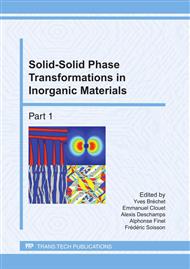p.1177
p.1183
p.1189
p.1195
p.1201
p.1207
p.1214
p.1220
p.1222
Analytical Modeling of Austenite Growth and Phase Evolution during Reverse Transformation from Pearlite in High Carbon Steels
Abstract:
Based on an analytical one-dimensional model, austenite growth into pearlite lamella and the corresponding phase evolution during isothermal reverse transformation to austenite at 1000-1183 K in Fe-C fully pearlitic steels containing 0.6-1.0 mass% C (in the austenite single phase field of Fe-C phase diagram) were simulated. It was found that the rate of austenite growth into ferrite increases faster with increasing reversion temperature than into cementite. Three types of phase evolution dependent on reversion temperature and carbon content were classified: 1) cementite rather than ferrite disappears first; 2) ferrite and cementite simultaneously disappear; 3) ferrite rather than cementite disappears first. The type of phase evolution in a hypoeutectoid steel heated above its Ae3 temperature possibly changes in the order of 1), 2) and 3) as the reversion temperature increases. For eutectoid and hypereutectoid steels, the phase evolution during isothermal reversion always obeys the type 3).
Info:
Periodical:
Pages:
1201-1206
Citation:
Online since:
June 2011
Authors:
Keywords:
Price:
Сopyright:
© 2011 Trans Tech Publications Ltd. All Rights Reserved
Share:
Citation:


